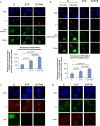Characterization of the interactions of PARP-1 with UV-damaged DNA in vivo and in vitro
- PMID: 26753915
- PMCID: PMC4709520
- DOI: 10.1038/srep19020
Characterization of the interactions of PARP-1 with UV-damaged DNA in vivo and in vitro
Abstract
The existing methodologies for studying robust responses of poly (ADP-ribose) polymerase-1 (PARP-1) to DNA damage with strand breaks are often not suitable for examining its subtle responses to altered DNA without strand breaks, such as UV-damaged DNA. Here we describe two novel assays with which we characterized the interaction of PARP-1 with UV-damaged DNA in vivo and in vitro. Using an in situ fractionation technique to selectively remove free PARP-1 while retaining the DNA-bound PARP-1, we demonstrate a direct recruitment of the endogenous or exogenous PARP-1 to the UV-lesion site in vivo after local irradiation. In addition, using the model oligonucleotides with single UV lesion surrounded by multiple restriction enzyme sites, we demonstrate in vitro that DDB2 and PARP-1 can simultaneously bind to UV-damaged DNA and that PARP-1 casts a bilateral asymmetric footprint from -12 to +9 nucleotides on either side of the UV-lesion. These techniques will permit characterization of different roles of PARP-1 in the repair of UV-damaged DNA and also allow the study of normal housekeeping roles of PARP-1 with undamaged DNA.
Figures





References
-
- Robert I., Karicheva O., Reina San Martin B., Schreiber V. & Dantzer F. Functional aspects of PARylation in induced and programmed DNA repair processes: Preserving genome integrity and modulating physiological events. Mol. Aspects Med. 34, 1138–1152 (2013). - PubMed
-
- Kim M. Y., Mauro S., Gevry N., Lis J. T. & Kraus W. L. NAD+-dependent modulation of chromatin structure and transcription by nucleosome binding properties of PARP-1. Cell 119, 803–814 (2004). - PubMed
-
- Ghodgaonkar M. M., Zacal N. J., Kassam S. N., Rainbow A. J. & Shah G. M. Depletion of poly(ADP-ribose) polymerase-1 reduces host cell reactivation for UV-treated adenovirus in human dermal fibroblasts. DNA Repair (Amst) 7, 617–632 (2008). - PubMed
Publication types
MeSH terms
Substances
Grants and funding
LinkOut - more resources
Full Text Sources
Other Literature Sources
Research Materials
Miscellaneous

